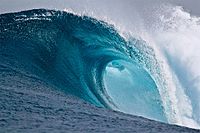
Photo from wikipedia
Sandbars, submerged ridges of sand parallel to the shoreline, affect surfzone circulation, beach topography and beach width. Under time-varying wave forcing, sandbars may migrate onshore and offshore, referred to as… Click to show full abstract
Sandbars, submerged ridges of sand parallel to the shoreline, affect surfzone circulation, beach topography and beach width. Under time-varying wave forcing, sandbars may migrate onshore and offshore, referred to as two-dimensional (2D) behaviour, and vary in planshape from alongshore uniform ridges to alongshore non-uniform ridges through the growth and decay of three-dimensional (3D) patterns, referred to as 3D behaviour. Although 2D and 3D sandbar behaviour is reasonably well understood along straight coasts, this is not the case for curved coasts, where the curvature can invoke spatial variability in wave forcing. Here, we analyse sandbar behaviour along the ∼3000 m man-made curved coastline of the Sand Engine, Netherlands, and determine the wave conditions governing this behaviour. 2D and 3D behaviour was quantified within a box north and west of the Sand Engine's tip, respectively, using a 2.4-year dataset of daily low-tide video images and a sparser bathymetric dataset. The northern and western sides behaved similarly in terms of 2D behaviour, with seasonal onshore and offshore migration, resulting in a stable position on inter-annual timescales. However, both sandbar geometry and 3D behaviour differed substantially between both sides. The geometric differences (bar shape, bar crest depth and wavelength of 3D patterns) are consistent with computed alongshore differences in breaker height due to refraction. The differences in the timing in growth, decay and morphological coupling of 3D patterns in the sandbar and shoreline are likely related to differences in the local wave angle, imposed by the curved coast. Similar dependency of bar behaviour on local wave height and angle may be expected elsewhere along curved coasts, e.g. shoreline sandwaves, cuspate forelands or embayed beaches. Copyright © 2017 John Wiley & Sons, Ltd.
Journal Title: Earth Surface Processes and Landforms
Year Published: 2018
Link to full text (if available)
Share on Social Media: Sign Up to like & get
recommendations!